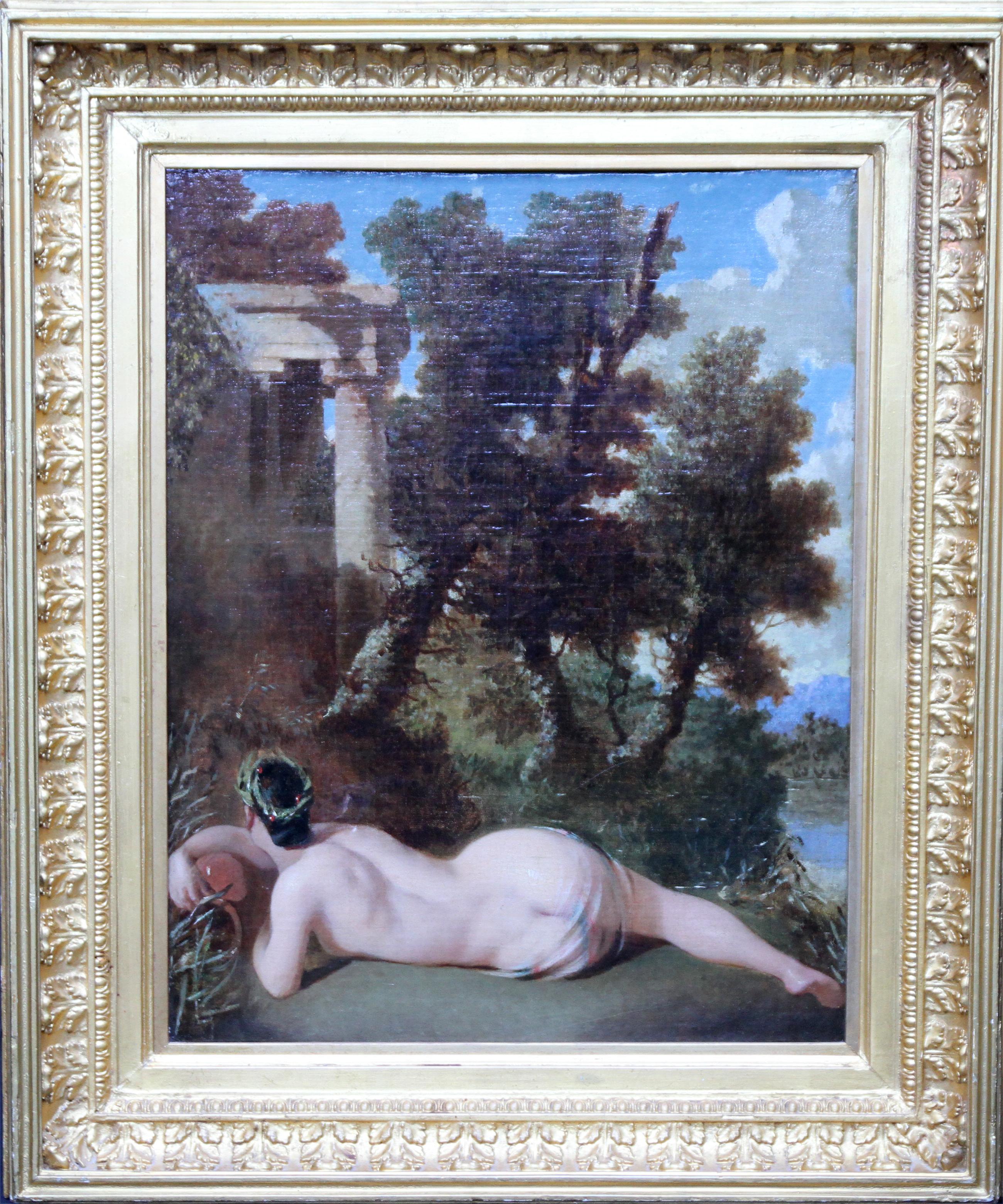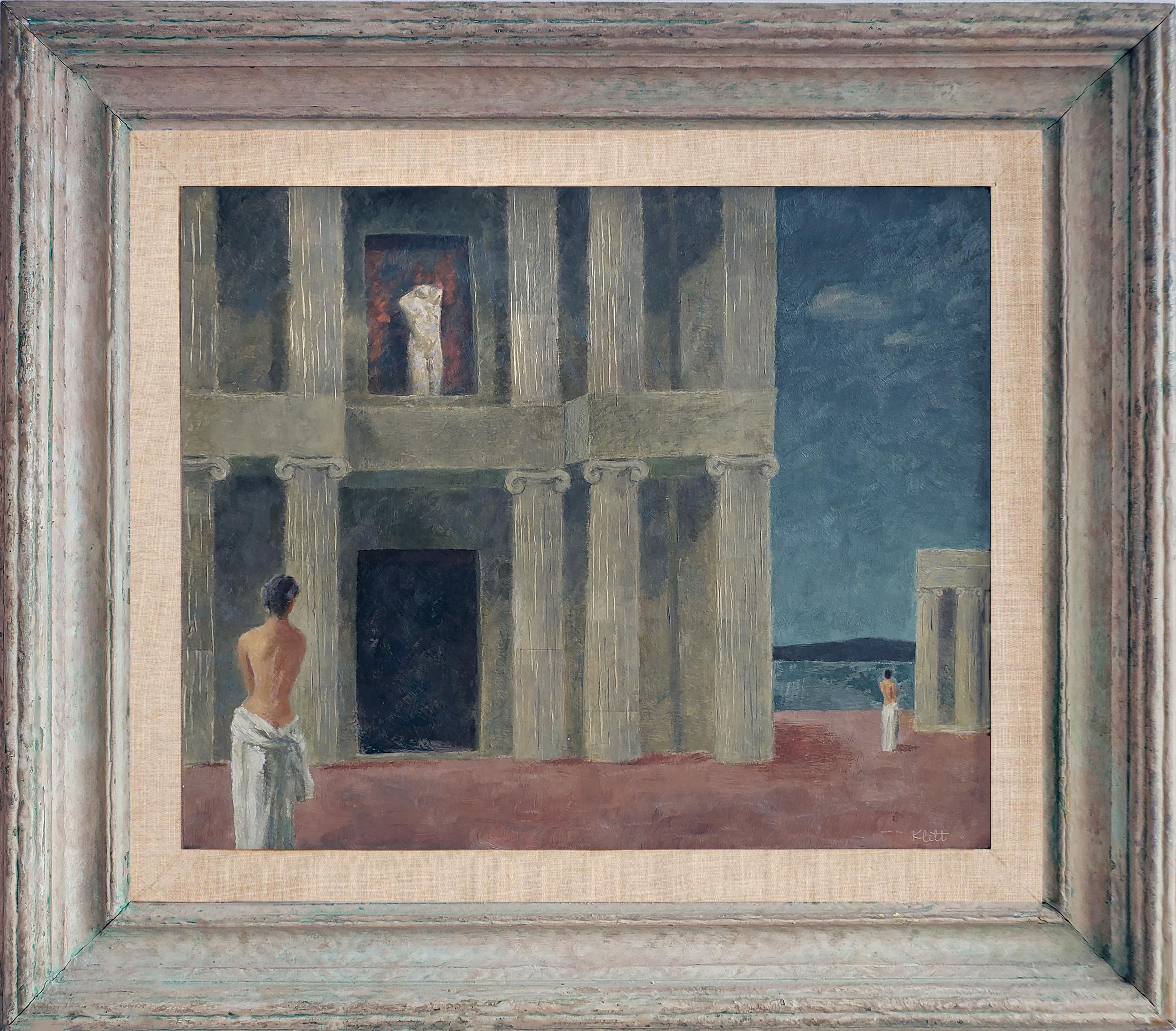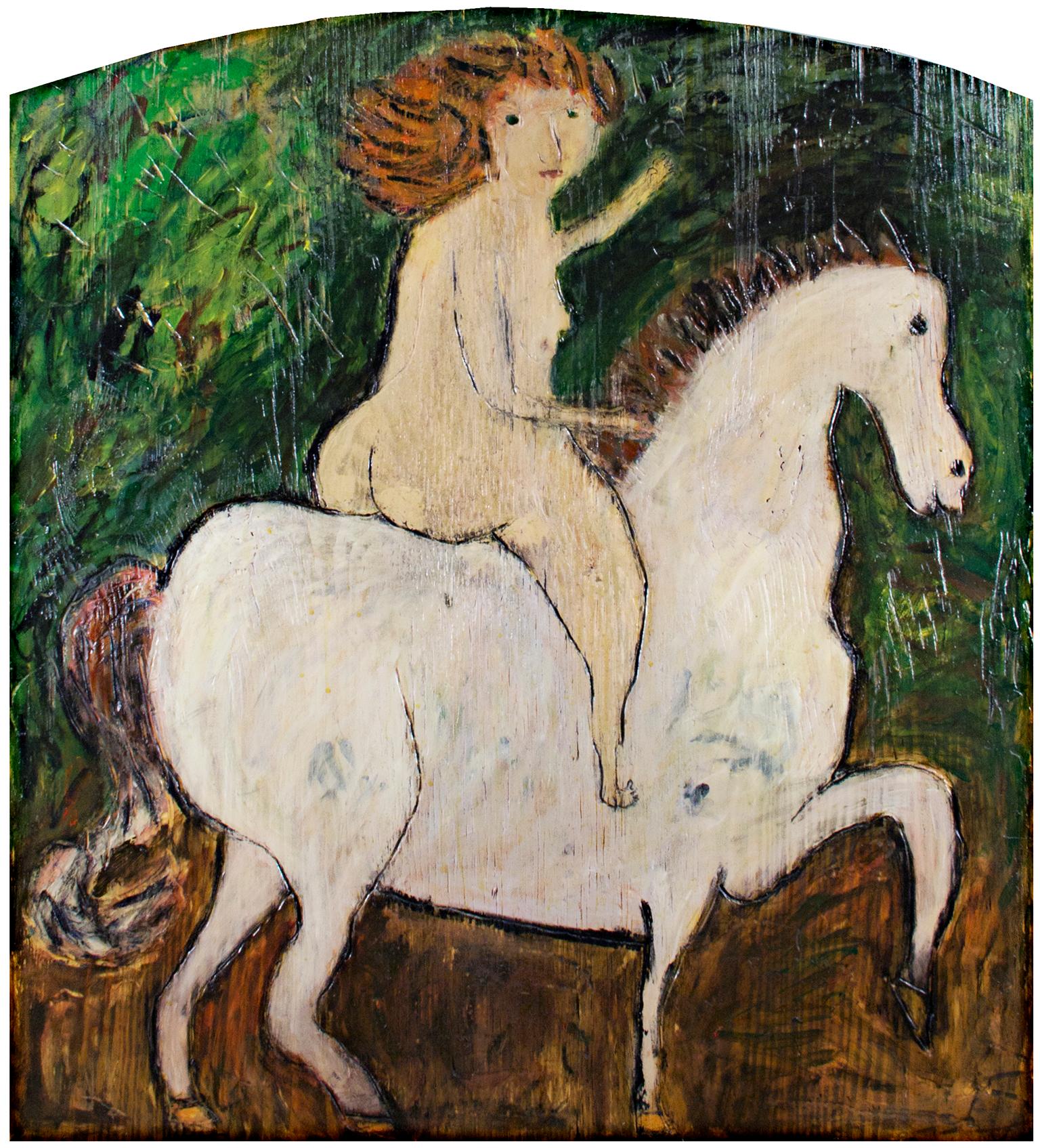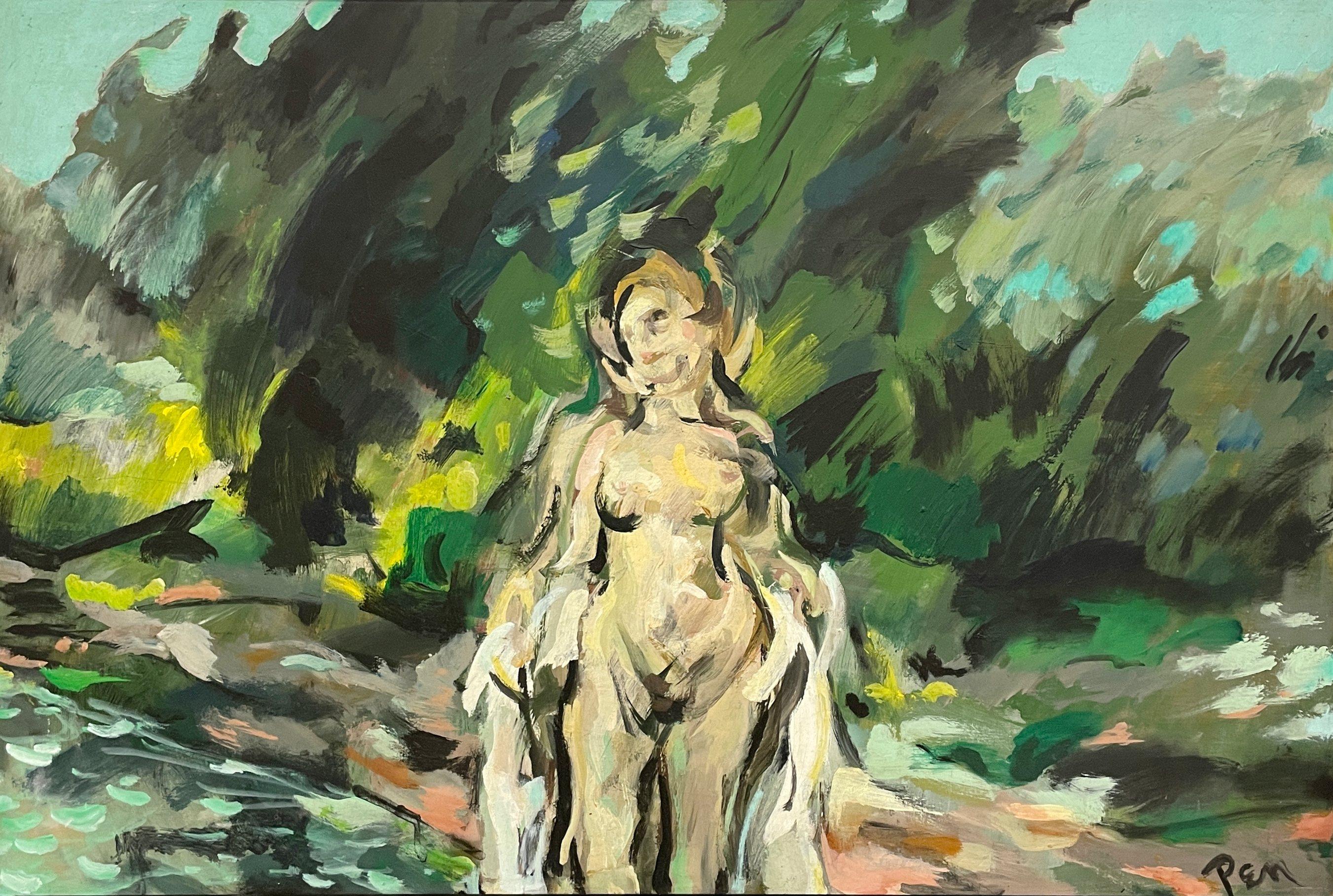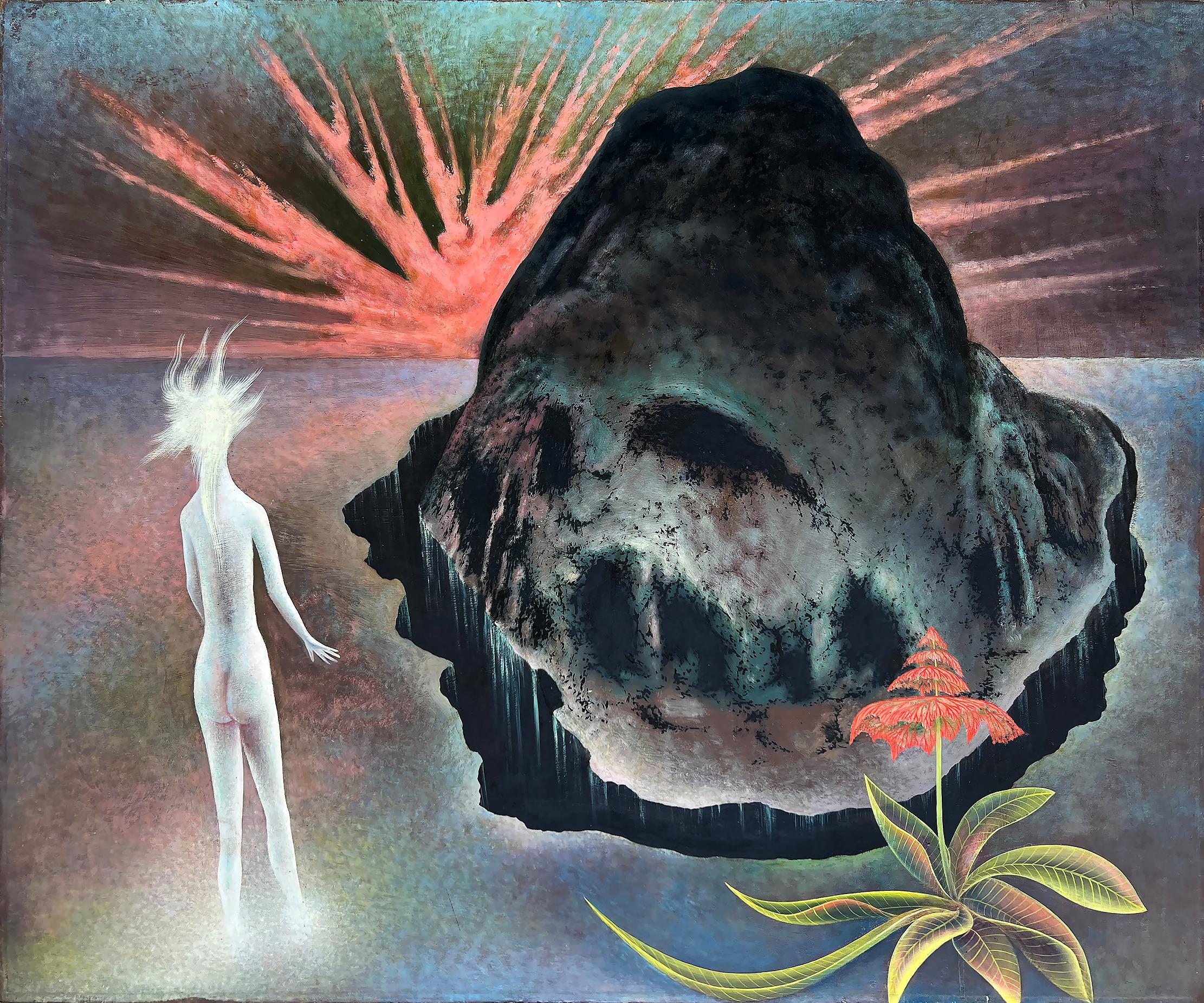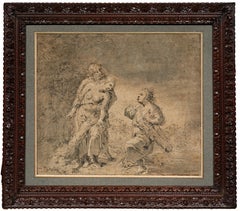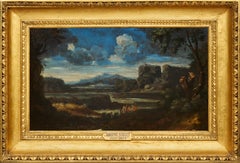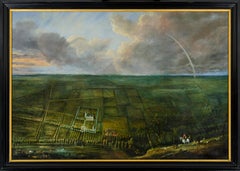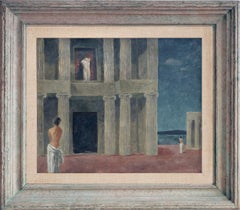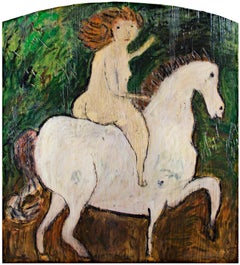Items Similar to Gathering in antique Ruins, a monogrammed painting by Jan van Haensbergen
Want more images or videos?
Request additional images or videos from the seller
1 of 10
Jan Van HaensbergenGathering in antique Ruins, a monogrammed painting by Jan van Haensbergen
About the Item
Jan van Haensbergen was a painter of the Dutch Golden Age and a pupil of Cornelius van Poelenburgh (Utrecht 1594 - 1667). The painting we are presenting is inspired by Poelenburgh’s landscapes from his Italian sojourn. The dreamlike atmosphere of this Gathering in antique ruins appealed to us. Against a backdrop of antique ruins, three draped characters (perhaps bathers) are sitting in a circle, greeting a fourth character walking towards them.
Their tranquility contrasts with the bustle of the other characters in the background. They constitute a vivid illustration of otium, this leisure time that allows us to realize our full potential. With this Arcadian landscape, Jan van Haensbergen invites us in turn to leave the hustle and bustle of everyday life behind, to take a break, to enjoy the present moment chatting with close friends…
1. Jan van Haensbergen, a landscape and portrait painter of the Dutch Golden Age
Jan van Haensbergen was born in 1642 in Gorinchem, a town in southern Holland to the east of Rotterdam. He was a pupil of Cornelius van Poelenburgh, and began by painting landscapes inspired by those of his master, in an Italianate style. Between 1668 and 1669, he was registered at the Guild of Saint Luke in Utrecht.
In 1669, he moved to The Hague, where he joined the Confrérie Pictura, an artist society founded in 1656. His portraits, which became his main activity as a painter after settling in The Hague, were strongly influenced by Caspar Netscher (Prague or Heidelberg 1639 - The Hague 1684), whom he met in The Hague and whose son Constantijn became his son-in-law by marrying his daughter Magdalena.
In addition to his work as an artist, Van Haensbergen was also an art dealer, probably helped by his appointment as Dean of the Confrérie Pictura, where he also teached.
2. Description of the artwork and related paintings
This painting seems to us to be a kind of allegory of otium, that quiet bliss promised by Epicurus. It might even evoke an Epicurean proverb: "It is better to lie on the naked ground and be at ease, than to have a golden carriage and a rich table and be worried" .
Three draped young people - two men and a woman in the background - are seated in a circle, greeting a fourth figure walking towards them, hair disheveled and body draped in a towel as if drying off after a bath, indicating the need for prior purification to fully enjoy this rest. Their nonchalance contrasts with the bustle of the various characters in the background.
The composition is punctuated by successive diagonals, and opens onto a landscape on the right, with a succession of mountainous planes. This painting is typical of the Italianate works produced by Van Haensbergen in the 1660s under the influence of Cornelis van Poelenburgh (without ever visiting Italy himself). A comparison with the Bath of the Nymphs from the Mauritshuis in The Hague (last photo in the gallery), dated 1665, leads us to believe that our painting is probably a later one, as the composition appears to be more structured than the one of the Mauritshuis painting, revealing the work of a seasoned painter.
Another painting with a similar subject attributed to Jan van Haensbergen (and formerly to Cornelis van Poelenburgh) is held in the Royal Museums of Belgium.
3. Provenance and framing
This drawing comes from the personal collection of dealer and expert Paul Touzet (1898 - 1981). Between the wars, he opened his first gallery on rue de l'Université in Paris. He then moved to rue des Beaux-Arts, where he was exhibiting mainly Dutch and Flemish paintings. In the 1960s, his main activity became expertise during public auctions, and he remained one of the most renowned experts in Paris until his death in 1981.
To frame this painting, we have chosen an Italian gilded and painted wood frame from the 17th century. Its warm gilding echoes the ochre colors of our painting, while the black highlights evoke the Dutch frames.
- Creator:Jan Van Haensbergen (1642 - 1705)
- Dimensions:Height: 12.63 in (32.09 cm)Width: 14.63 in (37.17 cm)
- Medium:
- Movement & Style:
- Period:
- Condition:8 ½” x 10 7/8” (215 x 275 mm) – Framed : 12 5/8” x 14 5/8” (32 x 37.3 cm) Monogrammed lower center "IVH" Italian 17th century gilded and painted wood frame from Lebrun.
- Gallery Location:PARIS, FR
- Reference Number:1stDibs: LU1568214659632
About the Seller
5.0
Vetted Professional Seller
Every seller passes strict standards for authenticity and reliability
Established in 2020
1stDibs seller since 2021
9 sales on 1stDibs
- ShippingRetrieving quote...Shipping from: PARIS, France
- Return Policy
Authenticity Guarantee
In the unlikely event there’s an issue with an item’s authenticity, contact us within 1 year for a full refund. DetailsMoney-Back Guarantee
If your item is not as described, is damaged in transit, or does not arrive, contact us within 7 days for a full refund. Details24-Hour Cancellation
You have a 24-hour grace period in which to reconsider your purchase, with no questions asked.Vetted Professional Sellers
Our world-class sellers must adhere to strict standards for service and quality, maintaining the integrity of our listings.Price-Match Guarantee
If you find that a seller listed the same item for a lower price elsewhere, we’ll match it.Trusted Global Delivery
Our best-in-class carrier network provides specialized shipping options worldwide, including custom delivery.More From This Seller
View AllDiana and Actaeon, a Mannerist painting after Joseph Heintz the Elder
Located in PARIS, FR
This painting seduced us with its rich colors. Depicting Diana and her companions surprised by Actaeon, it was inspired by an engraving by Aegidius Sadeler II after a painting by Jos...
Category
17th Century Old Masters Nude Paintings
Materials
Oil, Wood Panel
Silvio and Dorinda, a drawing by Leonaert Bramer, Vermeer's first master
Located in PARIS, FR
This finely executed drawing in pen and wash is typical of the work of Leonaert Bramer, one of the most fascinating yet little-known artists of 17th-century Holland.
In a nocturnal ...
Category
1650s Old Masters Figurative Drawings and Watercolors
Materials
Ink, Gouache, Laid Paper, Pen
Italian Landscape with Jack Players, a painting by Gaspard Dughet (1615 - 1675)
By Gaspard Dughet
Located in PARIS, FR
Here Gaspard Dughet offers us an idyllic vision of the Roman countryside. The stages follow one another in a perfectly structured composition, revealing here a lake, there travellers walking along, gradually leading our eye to the blue horizon. But behind its classical composition, this landscape is particularly interesting because of three anthropomorphic details that the artist has hidden, opening the way to a radically different interpretation...
1. Gaspard Dughet, a landscape artist in the light of Poussin
Gaspard Dughet was born on June 4th, 1615 in Rome where his father, of French origin, was a pastry cook. He was probably named Gaspard in honour of his godfather Baron Gaspard de Morant, who was, or may have been, his father's employer. His older sister Jeanne married the painter Nicolas Poussin (1594 - 1655) on September 1st, 1630. The young Gaspard was apprenticed with his brother-in-law at the beginning of 1631, which led his entourage to name him Gaspard Poussin. The first preserved works of the painter date from the years 1633-1634 and were painted in Poussin’s studio.
Around 1635, Gaspard Dughet became emancipated and began to frequent the Bamboccianti circle. In 1636, he became friends with the painter Jean Miel (1599 - 1656), but also with Pier Francesco Mola (1612 - 1666) and Pietro da Cortona (1596 - 1669).
This was also the time of his first trips throughout Italy. The painter, although of French origin, appears never to have visited France. In 1646 he settled permanently in Rome. A recognized painter with a solid book of orders, he remained faithful to landscape painting throughout his life, alternating between cabinet paintings and large decorative commissions, using both oil and fresco.
Nailed to his bed by rheumatic fever at the age of 58, he died on May 25, 1675.
2. Discovering an idealized landscape
Beyond a relatively dark foreground that takes us into the landscape, we discover a vast bluish horizon: a plateau surrounded by deep ravines advances to the right, overhanging an expanse of water that sparkles below. A road winds through a mountainous mass as if leading us to the fortress that crowns it; another town appears in the distance at the foot of three conical mountains.
The composition is rigorous, mineral, and structured by geometric volumes. The various stages in the landscape lead one to the next attracting the eye towards the horizon located in the middle of the canvas. The general impression is that of a welcoming and serene nature.
In many places the paint layer has shrunk, or become transparent, revealing the dark red preparation with which the canvas was covered and accentuating the contrasts.
Human presence is limited to three jack players, leaning against a mound in the foreground. Their long garments, which may evoke Roman togas, contribute to the timelessness of the scene.
Close examination of the canvas reveals two other travellers on the path winding between the rocks. Made tiny by the distance, their introduction in the middle register, typical of Dughet's art, lengthens the perspective.
While it is difficult to date the work of a painter who devoted his entire life to the representation of landscapes, it is certain that this painting is a work from his later years. The trees that occupied the foreground of his youthful compositions have been relegated to the sides, a stretch of water separates us from the arid mountains counterbalanced by two trees represented on the opposite bank. The introduction of this stretch of water in the middle of the landscape betrays the influence of the Bolognese and in particular of the Dominiquin (1581 - 1641)
A number of similarities with a drawing in the British Museum might suggest a date around 1656-1657, since, according to Marie-Nicole Boisclair , it has been compared with the Prado's Landscape with the Repentant Magdalene, painted at that period.
3. Three amazing anthropomorphic details
While some late Renaissance landscapes offer a radical double reading, allowing one to see both a face or a human body behind the representation of a landscape, it seems interesting to us to hypothesize that Gaspard Dughet had fun here by slipping in a few details that, taken in isolation, evoke human or animal figures.
We will give three examples, looking closely at a cloud, the trunk of a broken tree and the top of a cliff.
The main cloud could thus evoke a Christ-like face or that of an antique god...
Category
1650s Old Masters Landscape Paintings
Materials
Oil
Panoramic View of an Estate on the edge of the Sonian Forest (near Brussels)
Located in PARIS, FR
This museum-sized painting takes us over an estate on the outskirts of the Sonian Forest near Brussels, temptingly identified as the Ter Coigne estate in Watermael (of which only some heavily modified buildings remain today).
This gigantic "bird's eye view" is certainly a workshop painting, executed around 1650 by several artists under the supervision of Lucas van Uden...
Category
1650s Old Masters Landscape Paintings
Materials
Linen, Oil
Macbeth and the Three Witches a Painting on Panel by Francesco Zuccarelli
By Francesco Zuccarelli
Located in PARIS, FR
This painting, created during Zuccarelli's stay in England, represents the decisive moment when Macbeth, together with Banquo, meets the three witches who announce that he will be Ki...
Category
1760s Old Masters Landscape Paintings
Materials
Oil, Wood Panel
Mercury and Io, a rediscovered painting by Jean-Baptiste Marie Pierre (ca. 1740)
Located in PARIS, FR
We would like to thank Mr. Nicolas Lesur for confirming the autograph nature of the entire composition after a direct examination of the painting on November 27, 2024.
This painting...
Category
1740s Old Masters Figurative Paintings
Materials
Canvas, Oil
You May Also Like
Old Master Dutch Female Nude Arcadian Landscape - 19th century art oil painting
By (Attributed to) Isaac de Mucheron
Located in London, GB
An original oil on canvas which is attributed verso to Isaac Mucheron with figure by Vandveldt. The scene depicts a nude in an Arcadia classical landscape with ruins. Fresh colour an...
Category
Early 19th Century Old Masters Landscape Paintings
Materials
Oil
Hellenic Hypotenuse. Nudes among Greek Columns. Mid-Century Surrealism
By Walter Charles Klett
Located in Miami, FL
Klett was an in-demand illustrator in the post-war period of the late 1940's and 1950's. and . His work appeared in many of the newsstand magazines at the time.
This work is a pers...
Category
1940s Surrealist Nude Paintings
Materials
Oil, Masonite
Lure of the Waters 1946 oil painting by Philip Evergood
By Philip Evergood
Located in Hudson, NY
Exhibited at the Pennsylvania Academy of Fine Arts (1947) and the University of Illinois Exhibition of Contemporary Painting (1948), this painting by Philip Evergood exemplifies the ...
Category
1940s Modern Nude Paintings
Materials
Canvas, Masonite, Oil
"Lady Lee, " and "My Neighbors, " Oil on Wood signed by R. Richter, two-sided
By Robert Richter
Located in Milwaukee, WI
"Lady Lee" and "My Neighbors" are two original oil paintings executed on either side of a wood panel by Wisconsin artist Robert Richter. This fun and playful ...
Category
2010s Outsider Art Nude Paintings
Materials
Wood, Oil
A Captivating Mid-Century Modern Landscape Painting with Standing Female Nude
Located in Chicago, IL
A Captivating, Expressive Mid-Century Modern Landscape Painting with Standing Female Nude by Noted Chicago Artist, Rudolph T. Pen. This vibrant, colorful oil painting, depicting an a...
Category
Mid-20th Century Landscape Paintings
Materials
Masonite, Oil
Surrealist Landscape, Mountain with Nude Woman - Perls Gallery
By Frederick Haucke
Located in Miami, FL
A nude white woman gazes out and over a Giorgio de Chirico like surrealist landscape to an overly dramatic sunset with stylized orange rays. In the center of the composition is a cut-out of a mountain with a moat. In the extreme foreground is a silhouetted orange plane with a spiral of leaves. Along with the empty landscapes of de Chirico, it's possible that Frederick Haucke was influenced by Salvador Dalí " The Persistence of Memory" in 1931, and Dali's painting was shown at the Museum of Modern Art in 1934. In that painting, Dali, paints a vacant landscape doted with symbols from the unconscious. This painting by Frederick Haucke owes a debt to giants of the Surrealist movement but still, Haucke carves out his style. The shape of the nude's hair echoes the shape of the sunset. What the symbolism to the mountain is and the flower in the foreground we will leave to the viewer to speculate. It was shown at the very prestigious Pearls Gallery in New York City. Artists in the famous Perls' stable included Derain, Dufy, Rouault, Matisse, Picasso, Modigliani, Pascin, Soutine, Chagall and Vlaminck. With a 1971 retrospective of Alexander Calder's work. This Haucke from the Perls Gallery...
Category
1940s Surrealist Nude Paintings
Materials
Masonite, Oil
Recently Viewed
View AllMore Ways To Browse
Antique Gatherings
Used Van Seats
Jans Antiques
Oak Woman
One Of A Kind Mens
Painting Of Naked Woman
Italian Ruins Painting
Italy Ruins Painting
Dutch Golden Age Painting
17th Century Old Paris
Bath Photo
Walking Table
Antique Drawing 17th
Allegory Of Death
17th Century Dutch Table
Naked Men
Italianate Frame
Cornelius Hollander
